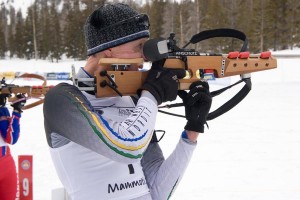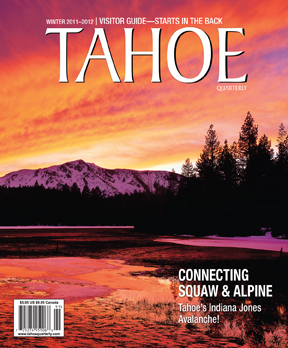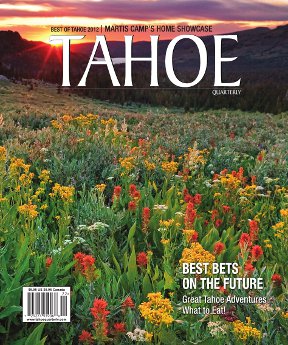Guns, skis and the push for biathlon at Tahoe

Biathletes like Glenn Jobe, pictured here, ski 10- to 20-kilometer courses, stopping to shoot (either prone or standing) at the range every 2.5 to 5 kilometers. Missed shots are penalized with extra 150-meter course loops or added time on the clock.
With the lung-bursting cardio of Nordic skiing and the precise, cool-headed aim of marksmanship, biathlon is a clear case of “opposites attract.” Though biathlon’s origins are rooted in Norwegian military training and its fan following is staunchly European, its coming-of-age took place in Tahoe. The discipline was first included in the 1960 Winter Olympic Games, at a range set up at Sugar Pine Point State Park, but the sport never found a permanent home here, not even when Olympic biathlete Glenn Jobe was based at Kirkwood in the early 1980s. But all that changed two years ago.
Finding a Home Range
“The timing was right,” says Jobe, now a Sierraville, California, resident, of the 2009–10 winter season when Northstar-at-Tahoe opened the only permanent biathlon facility on the West Coast. With the 2010 Winter Olympics, Squaw Valley’s 50-year Olympic celebration, and Northstar’s new program, biathlon entered Tahoe’s winter vernacular in a big way. “It was on TV, everybody wanted to try it, and Northstar offered the opportunity,” Jobe says.
But good times with guns are a hard sell to the brass, and with Vail’s acquisition of Northstar the biathlon program was shot down for the 2011–12 season, despite being a popular corporate group outing for the resort’s Ritz-Carlton clients.
However, the sport’s local following found backing in Truckee’s Preston Smart, who committed $25,000 towards moving the biathlon program to Auburn Ski Club’s (ASC) Soda Springs training center this winter. ASC was a partner in the Northstar course but never had the space or means for its own biathlon range. Thanks to Smart’s donation, along with his establishment of the Summit Foundation, a nonprofit that aims to promote and make local biathlon programming financially sustainable, ASC will now make use of the 12 lanes and 7 rifles donated by Northstar.
“We had a viable formula at Northstar, in terms of group and private lessons and open range days, so we’ll implement that over at Auburn Ski Club,” says Julie Young, the former director of the Northstar Cross-Country, Telemark & Snowshoe Center and the director of sports education for the new Summit Foundation. “This is going to be a healthy move for the program,” she adds, citing pluses that include ASC’s reputation as the center of Tahoe’s competitive cross-country community and the new site’s capability—and financial potential—of hosting summer biathlon, in which athletes run or mountain bike instead of ski.
Kids ‘N Guns
Before the course shift to the Soda Springs facility was official, ASC was already expanding its efforts, implementing a new youth program this past summer. Led by Jobe, the program is geared towards juniors up to 19 years old who’d like to pursue biathlon as a serious sport.
An even younger set is taking aim on Tahoe’s North Shore, where Tahoe Cross Country Ski Education Association director Valli Murnane started a laser biathlon program for grades three to five last winter season. Trading bullets for laser beams, the Take Aim on Fitness program, funded by a grant from Teichert Foundation, provides a safe, kid-friendly introduction to biathlon, and includes both indoor safety training and outdoor practice at Tahoe Cross Country’s Tahoe City location, as well as a 10-week indoor introduction at the Boys and Girls Club in Kings Beach. In its first season, 333 children tried the sport. Murnane hopes to expand the resort’s biathlon offerings to adults; a point-scored system of competition is under consideration.
Building Biathlon Tradition
Local biathletes can test their competitive mettle at the 10th Mountain Division Biathlon Race February 26 at Auburn Ski Club’s Soda Springs course; training clinics will be offered on that Saturday. Overall, the increased level of enthusiasm for the sport in the Sierra bodes well for biathlon in this part of the country.
“It’s really important that we have this winter opportunity here,” says Jobe of the new permanent range at ASC. “We can now build biathlon on the West Coast; there’s enough interest in Mammoth and the Tahoe Basin to make it feasible.” TQ. By Lis Korb.






